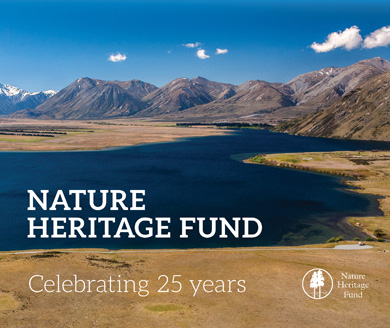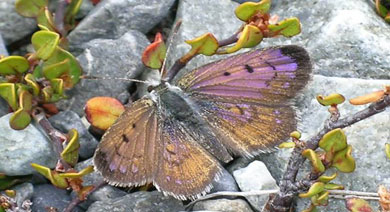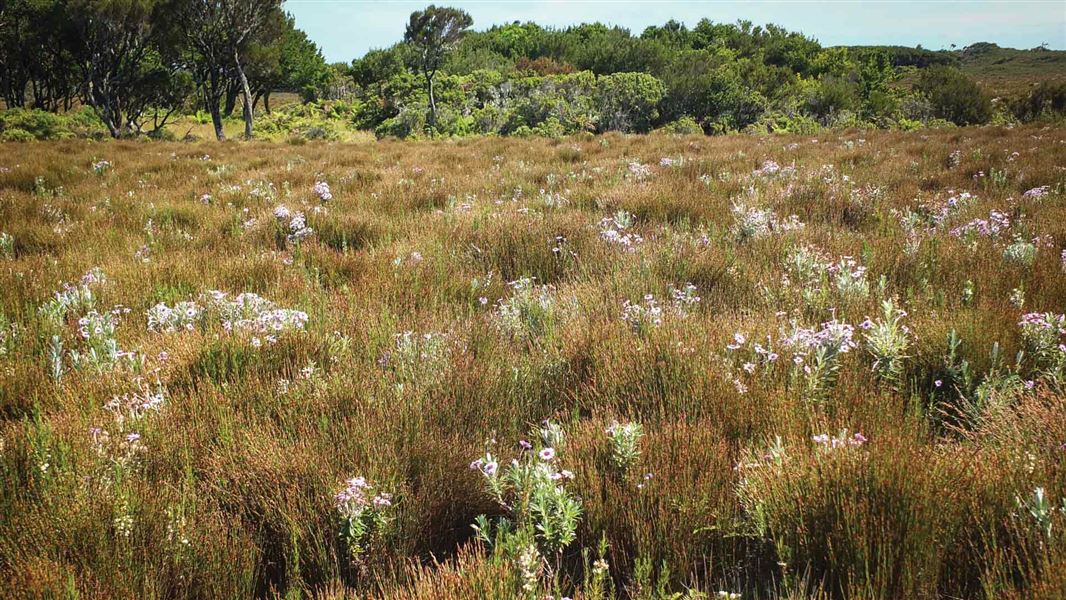
Nature Heritage Fund – Celebrating 25 years anniversary publication cover
The Nature Heritage Fund is a contestable Ministerial fund that was established in 1990 to help achieve the objectives of the Indigenous Forest Policy. In 1998 the scope of the fund was widened to include non-forest ecosystems.
The fund is administered by an independent committee appointed by the Minister of Conservation under section 56 of the Conservation Act 1987. It is serviced by DOC and in the 2022/23 financial year received an annual allocation of approximately $1.8 million from the Government.
Since 1990 the fund has protected over 349,000 ha of indigenous ecosystem through legal and physical protection (ie direct purchase or covenanting). See a map of areas protected by the fund.
Much of this land would otherwise have been logged, cleared or further damaged by introduced browsing mammals.
Vision, objective and scope
The vision of the Nature Heritage Fund is to protect indigenous ecosystems that represent the full range of natural diversity originally present in the landscape through the establishment of a sustainable and interacting system of protected areas.
The objective is to enable, facilitate, and support activities directed at the protection of indigenous ecosystems, through helping to permanently protect representative, sustainable, landscape and amenity values of indigenous ecosystems. It does this by purchase of interest, or, while leaving the land in private ownership, through covenanting, leasing, accords, and management agreements.
The fund’s scope includes all indigenous terrestial ecosystems that in their local or national context are considered important ecologically. It includes indigenous forests, wetlands, tussock lands and coastal ecosystems on private land.
Methods of protection

Lycaena butterfly
Image: Brian Patrick ©
The Nature Heritage Fund helps meet the cost of protecting areas of high ecological value by providing contestable finance for projects that protect ecosystems. Some options for protecting ecosystems include:
Direct purchase: The fund provides the finance and negotiates the purchase of areas in need of protection for its clients. The fund also contributes towards purchases made by local authorities or other agencies prepared to manage protected areas as reserves under the Reserves Act 1977.
Covenanting: Where landowners want to protect natural areas, but not relinquish title to their land, these areas can be covenanted. A covenant is a legal agreement that protects the area, in perpetuity, and is registered against the title of the land. The Nature Heritage Fund provides assistance with fencing, survey and legal costs.
Core criteria
Proposals are assessed against four core criteria listed below as well as other material required in applications.
1. Representativeness: Ensures that viable or sustainable examples of all natural ecosystems are protected by approximately the same proportions in which they were originally present in the natural landscape. The aim is to protect both common and rare species habitats and communities, and the ecological processes and interactions that link them.
2. Sustainability: Ensures that the natural values proposed for protection can be sustained within the protected area by determining whether the values for which the area is protected will persist in the long term. Size and shape of the protected area, how well it is protected or buffered from the effects of surrounding land uses, and existing and potential threats are all considered, along with linkages to other protected areas.
3. Landscape integrity: The extent to which an ecosystem contributes to the original integrity of the landscape. It is important to ensure the original character, context and range of processes that link the various ecosystems are maintained, along with the natural nutrient cycles, energy flows and hydrology.
4. Amenity and utility: Natural ecosystems contribute to people's physical and spiritual welfare, providing educational, heritage, recreational, tourist and other amenity value. They also contribute ecosystem services including conserving soil, maintaining water quality and supply, and storing carbon.
Questions about criteria
The application of each criterion should be guided by the statements above and questions below. The questions are designed to help ensure that applicants give full consideration to the fund’s criteria when completing their applications.
Applicants need not answer each question, but should ensure that the information provided with their application includes consideration of all the main concepts covered in the questions.
Adequate consideration of these questions will help ensure the fund’s committee has sufficient information to assess the ecological parameters of applications. As the fund is concerned with the total ecosystem, all vegetation types should be assessed when responding to these questions.
Questions on representativeness
- What ecological district and ecological region is the area in?
- How well does the area represent the indigenous biodiversity, plant and animal communities that were originally present in the ecological district; especially those which have now been reduced?
- Are the communities and habitats present in about the same proportion as they originally were in the ecological district?
- How intact is the area; are the processes that link the species, habitats and ecosystems functioning in a natural way?
- To what extent do the communities present in the area represent the full range of communities in the ecological district: how many recognisable communities are present within the area?
- How well does the area protect important populations of rare or endangered species; does it support minimum viable populations of these species?
- Does the area provide seasonal habitat or food resources for important indigenous animal populations normally resident outside the area?
- How well are the ecosystems or communities within the area protected elsewhere in the ecological district?
- Does the area include any uninterrupted ecological sequences, such as across changing altitude, soil type, or moisture?
- If already modified, how well will the ecosystem expected to be present in the area in the future represent indigenous character of the ecological district?
Questions on sustainability
- What size and approximate shape is the area?
- Is the area large enough to adequately sustain the ecosystems present; is there sufficient opportunity for continued regeneration and evolution of the indigenous communities, including ecotones and altitudinal migration?
- How wide is the area at its narrowest point?
- What land-use activities occur on the boundaries of the area, particularly at its narrowest points, upstream or upwind, and how well is the area buffered from the effects of these activities?
- Does the area adjoin any other protected area; how significant is this link?
- Is the area resilient to introduced species; are plant and animal pests present, what are their effects, and can they be controlled?
- Is the area threatened by any natural disturbance events, such as rising sea level, flooding, drought or landslide; could the communities present endure these events by, for example, gradual movement inland or upslope in response to climate change, or natural regeneration following landslides, flooding or drought?
- How easily can the area be managed to maintain the values for which it is protected?
- How likely are the ecosystems of the area to retain their indigenous character in the long term?
- If already modified, are the restoration efforts proposed for the area able to be maintained for the term of the restoration process?
Questions on landscape integrity
- Describe the area in terms of its landscape context; how does it fit in with the surrounding landscape?
- Is the area recognised locally (or regionally/nationally) as an important landscape feature; is it listed in the District Plan or in any other landscape assessment?
- How significant is the area to the functional coherence of the original or remaining landscape; do the plant communities of the area stand out as an isolated feature in the landscape, or do they blend or merge with the surrounding plant communities?
- Is the area important for landscape integrity; does it link existing plant communities or protected landscapes?
- What proportion of the catchments of the streams or rivers of the area is protected within the area, or already protected outside the area?
- How important is the protection of this area for landscape protection; is it an unprotected enclave within a surrounding protected area, or does it contribute significantly to the landscape character of the area?
Questions on amenity and utility
- How effectively does the area protect parts of a catchment above important water intakes for domestic, urban, farming or industrial use?
- How effectively does the area protect soils from erosion?
- Is the area important for recreation and/or tourism?
- Is the area part of an important area for the appreciation of nature and for spiritual renewal?
- What does the area mean to the local community and do they support its protection?
- Is the area important to the wider area’s pleasantness and aesthetic coherence?
- Does the area contain any listed geopreservation sites?
- Does the area contain any recognised historical or archaeological sites, or any features or values that are important to tangata whenua?
Contact
For further information about the Nature Heritage Fund:
Phone: 0800 86 20 20
Email: NHF-Admin@doc.govt.nz
Post:
The Funds Advisor
Nature Heritage Fund
PO Box 10-420
Wellington 6143
